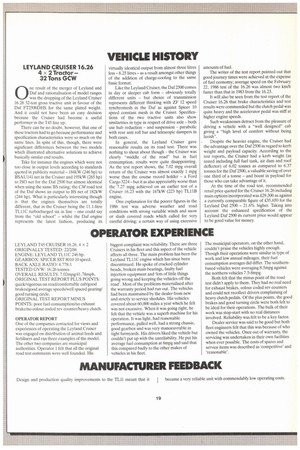OPERATOR EXPERIENCE
Page 179

If you've noticed an error in this article please click here to report it so we can fix it.
LEYLAND145 CRUISER 16.26.4 x 2 ORIGINALLY TESTED: 22/2/86 ENGINE: LEYLAND TLI1C 246 hp. GEARBOX: SPICER SST 8010 10 speed. BACK AXLE RATIO: 4.778:1 TESTED GVW: 16.26 tonnes OVERALL RESULTS: 7.02mpg/41.78mph. ORIGINAL TEST REPORT PLUS POINTS: quick/vigorous on road/comfortable cab/good brakes/good average speeds/well spaced gearing/ good turning circle.
ORIGINAL TEST REPORT MINUS POINTS: poor fuel consumption/no exhaust brake/no colour coded rev counter/heavy clutch.
OPERATOR REPORT One of the companies contacted for views and experiences of operating the Leyland Cruiser was engaged on distribution of animal feeds and fertilisers and ran three examples of the model. The other two companies are municipal authorities. Operator 1 felt that all the original road test comments were well founded. His ill biggest complaint was reliability. "[here are three Cruisers in his fleet and this aspect of the vehicle affects all three. The main problem has been the Leyland TL 1 IC engine which has since been discontinued. He spoke of cracked cylinder heads, broken main bearings, faulty fuel injection equipment and 'lots of little things going wrong and keeping the vehicles off the road'. Most of the problems materialised after the warranty period had run out. The vehicles had been maintained by the dealer from new and strictly to service shedules. His vehicles covered about 60,000 miles a year which he felt was not excessive. When it was going right, he felt that the vehicle was a superb machine for his operation. It was light, had reasonable performance, pulled well, had a strong chassis, good gearbox and was very manoeuvrable in tight farmyards. His drivers liked the vehicle but couldn't put up with the unreliability. He put his average fuel consumption at 6mpg and said that this compared badly to the other makes of vehicles in his fleet.
l he municipal operators, on the other hand, couldn't praise the vehicles highly enough. Though their operations were similar in type of work and low annual mileages, their fuel consumption averages did differ. The southernbased vehicles were averaging 8.5mpg against the northern vehicles 7.5-8mpg.
Both felt that the minus point of the road test didn't apply to them. They had no real need for exhaust brakes, colour coded rev counters and could not recollect drivers complaining of heavy clutch pedals. Of the plus points, the good brakes and good turning circle were both felt to be ideal for their operations. The bulk of their work was stop-start with no real distances involved. Reliability was felt to be a key factor.
Dealer service was said to be good but both fleet engineers felt that this was because of who owned the vehicles. Once out of warranty, the servicing was undertaken in their own facilities when ever possible. The costs of spares and service items was described as 'competitive' and 'reasonable'.
































































































































































































